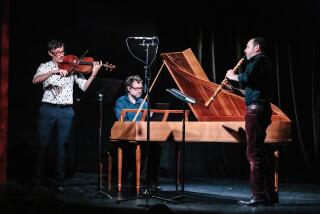Mary Kaye, 83; singer brought all-night lounge acts to Las Vegas
- Share via
Mary Kaye, a singer and guitarist who is credited with introducing the word “lounge” into the lexicon of Las Vegas shows and whose jazz trio helped pioneer all-night performances on the strip’s secondary stages, has died. She was 83.
Kaye, who had been in declining health, died Saturday of heart and respiratory failure at Mountain View Hospital in Las Vegas, said Norman Kaye, her brother and a member of the Mary Kaye Trio.
In about 1950, the trio was winding up its first engagement in the main showroom of the Last Frontier on what would become the Las Vegas Strip, and the owner wanted to keep them performing at the hotel.
“Without a room to go to, I suggested a stage be built in the bar area, and it could be called a ‘lounge,’ ” Mary Kaye told Vintage Guitar magazine in 2003.
Norman Kaye told The Times on Monday, “We were the first lounge group advertised as such.... It was a marvelous career for all of us.”
The group performed between 1 and 6 a.m. on the newly enclosed stage, helping to turn Las Vegas into a 24-hour town, Mary Kaye told Guitar Player magazine in 2006.
Before the lounge era, the town tended to close down during those hours, she recalled.
During the trio’s first week in the Last Frontier lounge, Frank Sinatra and friends dropped $120,000 gambling while hanging out with the “dusk till dawn crowd” -- the nickname given to patrons of the free overnight shows, Mary Kaye said in Guitar Player.
Celebrities often took in their lounge act -- including Elvis Presley, who watched from backstage, according to a family history.
The best-known incarnation of the trio included Mary Kaye on guitar, her older brother Norman on bass and Frank Ross, the group’s comedian and sometimes accordionist.
“They changed the history of Las Vegas,” George Schlatter, a 1950s booking agent who became a film and television producer, told the Las Vegas Review-Journal this week. “They were all over the room and they were hysterical. Anybody who ever saw the act realized this was the most sound you ever got out of three pieces.”
The trio worked an average of 36 weeks a year, often appearing at the Sahara and Tropicana hotels. The group recorded dozens of songs, including “My Funny Valentine” and “April in Paris,” and released a dozen albums before breaking up in 1966.
“I never thought the band would end,” Kaye told Guitar Player, but there was friction over who should control the business. After the last show, at the Tropicana, she said, “Charlton Heston came into my dressing room and cried with me.”
Mary Kaye, who continued performing as a solo artist into the 1970s, also had a guitar nicknamed after her, although she rarely played it.
In 1956, she posed for a publicity photograph with a blond 1950s Fender Stratocaster. That year, images of her playing the guitar in the film “Cha-Cha-Cha-Boom!” appeared on lobby cards, Vintage Guitar reported.
Guitar aficionados came to refer to it as the “Mary Kaye model,” although she usually used D’Angelico guitars. In 2005, Fender released a limited-edition Stratocaster named for her.
Mary Ka’aihue was born into a musical family on Jan. 9, 1924, in Detroit and raised in St. Louis.
Her grandfather was Prince Kuhio, brother of Queen Liliuokalani, who was the last monarch of Hawaii and wrote many musical standards, including “Aloha ‘Oe.”
Her father was known professionally as Johnny Ukulele. By age 12, Kaye and her brother were performing with his band, Johnny Ka’aihue’s Royal Hawaiians. Her mother had died when Mary was 3.
Because of musical differences, Kaye split off from her father’s group and formed her first trio. It included Jules Pursley, whom she married.
Norman Kaye returned from serving in World War II to see the jazz group perform but was put off by its name -- the Mary Ka’aihue trio -- because he felt audiences would expect to hear Hawaiian music. He soon joined the group, and the siblings began using Kaye as their family name.
A brief Los Angeles Times review of a 1949 performance at the Orpheum Theatre declared the trio “atomic when they get into full swing” and concluded: “They have style, energy, ingenuity.”
In addition to her brother, Kaye’s survivors include her three children, Jeffrey Pursley of Calabasas; Donna Ramirez of Las Vegas; and Jaye Kaye of Mallorca, Spain; and nine grandchildren.
More to Read
The biggest entertainment stories
Get our big stories about Hollywood, film, television, music, arts, culture and more right in your inbox as soon as they publish.
You may occasionally receive promotional content from the Los Angeles Times.











